Last Updated: April 2024
Not a lot has changed since my last update in January but I have added the monochrome Boox Note Air3 to the ‘Best All-Round’ category and added the Supernote A6X2 Nomad to the ‘Best Small Tablet’ category.
In this article, I will list what I feel are the best e-ink writing tablets currently on the market and explain the reasons why I love them.
Unlike other ‘best e-ink tablet‘ webpages I’ve seen, I have actually bought, tested and regularly use the devices I review – here’s a picture of me with a selection of my tablets.
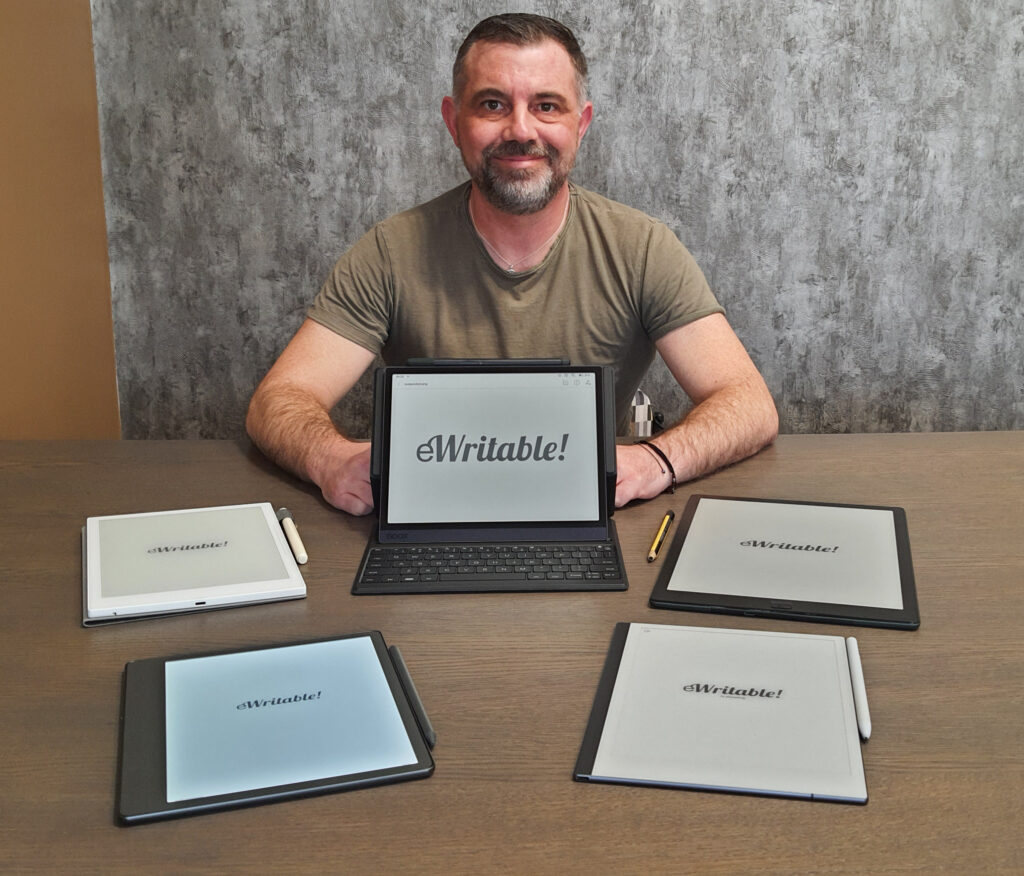
I think every single device listed on this page is awesome, but for very different reasons – it was very difficult to rank them (and I very often changed my mind) but in the end, I based it primarily on which device I use the most or regularly reach for when I want to take some notes.
However, please bear in mind that these are my own subjective views based on my own personal needs, preferences and workflows. Depending on your own requirements, any of these eNotes would be a good investment.
To further help your decision-making, I’ve built a tool for searching and comparing e-ink tablets that you may find useful.
What is an E-Ink Writing Tablet?
E-ink tablets (also known as eNotes and ePaper) are electronic tablets that can be used for writing and sketching using stylus-based input. They can be perhaps be thought of as an infinite stack of paper, and are often used as a replacement for traditional notepads and sketchbooks.
They differ from LCD and OLED devices such as Apple’s iPad because they use an E-ink display. This is the same technology used on Amazon Kindle screens, and it looks and feels like real paper (well, as close as you can get from a digital device).
Moreover, they don’t emit light, so they can be more comfortable for the eyes and can be viewed clearly outside, even on sunny days. And they usually consume very little power, so can last for several days (and even weeks) without needing a recharge.
The main drawback is that they have a low refresh rate, which means that although they are ideal for reading, writing, and sketching, they are not ideal for looking at things that are constantly moving, such as games or videos (although some manufacturers have developed proprietary refresh technology that is closing this divide).
You can get a good overview of the advantages and disadvantages of e-ink tablets in my Beginner’s Guide.
Best All-Round E-Ink Tablet: Boox Note Air3 C
Pros
- Colour screen
- High screen resolution/density
- Great hardware specs
- Very versatile
- Sophisticated native reading & note-taking apps
- Scratchy writing feel
- Handwriting search/conversion
- Google Play Store
- Frontlight
- Onboard GPU & Boox Super Refresh Tech
- Audio (speakers and microphone)
- MicroSD card slot
Cons
- Steeper learning curve
- GPU/Super Refresh uses more power
- Screen is darker than monochrome e-ink tablets
- Some ghosting when the screen changes
- Lots of options can lead to less focused work
Where to buy?
Boox Euro Shop, Boox Shop, Reseller (CA), Amazon BE, Amazon DE, Amazon ES, Amazon FR, Amazon IT, Amazon NL, Amazon PL, Amazon UK, Amazon US, eBay AU, eBay CA, eBay DE, eBay ES, eBay FR, eBay IE, eBay IT, eBay UK, eBay US,Top-of-the-range hardware and software combined with a pleasurable writing experience makes the Note Air3 C one of the most versatile and capable e-ink tablets on the market.
The Boox Note Air3 C (NA3C) is, in my opinion, the best e-ink tablet that you can buy right now.
However, in the interests of transparency, I must add the disclaimer that it is not the tablet I use most in my day-to-day work – that accolade goes to the Supernote A5X (below) – but I do use the NA3C quite a lot as well!
And the reason for me putting the NA3C in first place is because it can simply do far more than the Supernote (which is designed to be a dedicated note-taking device).
The NA3C has a colour screen, frontlight (with warmlight), speakers, microphone, and Bluetooth. It has a fast 2.4GHz octa-core processor, an integrated GPU, 4Gb RAM and 64Gb storage. There are very few other e-ink tablets that can compete with these top-notch specs.
In terms of software, it runs Android 12 and has access to the Google Play Store, which means that third-party apps (e.g. Google Chrome, Facebook, Kindle etc.) can be installed on it. And Boox’s own native e-reading and note-taking apps are also top-class.
In addition, by using a combination of the onboard graphics processor and proprietary software (Boox Super Refresh – BSR), the NA3C (along with all of Boox’s newer tablets) are able to adjust the refresh rate on a per-application basis, which makes more third-party apps usable on an e-ink screen. For example, on older e-ink tablets, scrolling down a webpage would be a pain because the page would keep flickering and refreshing. BSR makes this whole experience much smoother.
However, all this raw power can drain the battery quicker – I get just over a day’s use out of it before it needs a recharge. And the inherent nature of the colour Kaleido 3 screen does mean that it is visibly several shades darker than a monochrome e-ink screen, resulting in lower contrast if the frontlight is turned off. I’ve written about the pros and cons of colour e-ink screens here.
So, if you are looking for the e-ink writing tablet that is on the cusp of e-ink technology and offers a great deal of power and versatility, then Boox’s Note Air3 C is a very good choice.
Update: Boox have released a monochrome version of the Note Air 3. Although it does not have colour or BSR, the screen is brighter, it has better battery life and is about $100 cheaper. This joins the Note Air3 C in my top all-round category. Check out my comparison here, the specs here, and my review here.
Alternative options: Bigme Inknote Color+, Bigme Inknote Color+ Lite, Boox Note Air2+ (monochrome), Boox Note Air3 (monochrome)
Best Dedicated Note-Taker: Supernote A5X
Pros
- Fantastic substitute for a paper notebook
- Ceramic stylus tips that never need replacing
- Lovely writing feel
- Quick and easy navigation
- Well-structured notebooks
- Best handwriting search
- Excellent after-sales service
- Nice range of additional tools (Email / Calendar / Word Doc editor / Kindle etc.)
Cons
- Steeper learning curve
- Notebooks not easily viewable on other devices when using third-party clouds
- Partner app requires more work
- No frontlight
- No auto-synchronisation
Where to buy?
Ratta Supernote, Supernote EU (not UK), Supernote Outlet, eBay AU, eBay CA, eBay DE, eBay ES, eBay FR, eBay IE, eBay IT, eBay UK, eBay US,The Supernote A5 X (and smaller A6 X) are perhaps the best digital replacements for paper-based notebooks for those that love to write.
Whilst Supernote e-ink tablets have nowhere near the flexibility of those manufactured by Boox, they have been designed to do one task (note-taking) exceptionally well.
And it is for this reason that my Supernote A5X is my constant companion. As a note-taking device, it is just so effortless to use, just like my traditional paper notebooks were. I simply open my notepad, flick to the next bank page and write.
The native note-taking software has some really nice and unique features that I really can’t live without. For example, when I start a new page, I write the title at the top, and then lasso-select it and turn it into a heading and the Supernote automatically builds me a Table of Contents based on my headings. I can also draw a five-pointed star anywhere on the canvas to mark the page as important and then do a search for all my stars so that I can action them. There is a touch-sensitive swipe bar on the right-hand bezel which brings up a quick access menu whatever I am doing so that I can quickly flick between notebooks and documents. And the handwriting search feature is supremely fast.
But whilst it is a very innovative and useful note-taking tablet, it is not designed to replace any of the tasks that you would perform on your computer or laptop. True, it has an email client, and a calendar (that syncs with your Google/Outlook calendar). But these are provided more for convenience rather than productivity – it’s useful to check your email box and schedule but you wouldn’t want to be writing lengthy emails using the on-screen keyboard.
And the native reading app is pretty decent, but not as good as the likes of Boox or Kindle devices. You can install the Kindle app, but the Supernote lacks a frontlight, so reading can potentially be a bit uncomfortable if there is not enough ambient light.
I make it no secret that I am also a big fan of Supernote’s commitment and dedication towards their customers and the sustainability of their devices. They are one of the few e-ink tablet manufacturers that genuinely listen to and value customer feedback, and the only manufacturers that has publicly published a roadmap of their software development plans. They design their products to last for the long-haul, with their latest model being the first e-ink tablet to have a replaceable battery. And they are offering discounts on their new tablet for existing customers whose devices are a couple of generations behind (as well as discounts for students, first-responders, and veterans). I just really like the way that they do business 🙂
And, for me, many of the things that should perhaps be considered drawbacks of the Supernote (lack of versatility, monochrome screen, no frontlight, etc.) actually add to the tablet’s charm because it provides a pleasant and minimalistic writing experience without any distractions. And the plastic casing and stripped back hardware makes it lightweight and easy to hold and carry. But I can also acknowledge and appreciate that this does not suit the needs of everybody (which is why the Boox Note Air3 C is at the top of my list).
NOTE; Ratta Supernote has stopped production of the A5 X in anticipation of the A5 X2 to be released in 2024.
Alternative options: Supernote A6 X, reMarkable 2, Boox Note Air3 C, Boox Note Air2+
Best E-ink Laptop: Boox Tab Ultra C Pro
Pros
- Colour screen
- High screen resolution/density
- Great hardware specs
- Very versatile
- Sophisticated native reading & note-taking apps
- Handwriting search/conversion
- Google Play Store
- Frontlight
- Onboard GPU & Boox Super Refresh Tech
- Audio (speakers and microphone)
- MicroSD card slot
- 16Mpx camera
- Optional Keyboard Folio
Cons
- Steeper learning curve
- GPU/Super Refresh uses more power
- Screen is darker than monochrome e-ink tablets
- Some ghosting when the screen changes
- Lots of options can lead to less focused work
- Some chassis design flaws
- Writing feels a little 'slippy'
Where to buy?
Boox Euro Shop, Boox Shop, Reseller (CA), Amazon BE, Amazon DE, Amazon ES, Amazon FR, Amazon IT, Amazon NL, Amazon PL, Amazon UK, Amazon US, eBay AU, eBay CA, eBay DE, eBay ES, eBay FR, eBay IE, eBay IT, eBay UK, eBay US,On paper, it's the most powerful e-ink tablet on the market and is very impressive, but I feel that practical use cases will be limited.
In terms of sheer power and versatility, the Boox Tab Ultra series is the creme-de-la-creme of e-ink devices. And the latest tablet in this product range is the Boox Tab Ultra C Pro (TUCP). This is about as close as you can get to a regular laptop with an e-ink screen.
It shares many of the features of the Boox Note Air3 C, including a 10.3″ colour screen, the same operating system (Android 12, but with a slightly different launcher) and the same native software.
However, the specs have been souped-up a little, with a 2.8GHz octa-core processor, 6Gb of RAM, and 128Gb of storage space. This makes the performance a little snappier, particularly if you do a lot of multitasking or run resource-hungry apps. In addition, it has 16Mp rear-facing camera, a bigger battery, and an optional keyboard/trackpad folio (which will set you back an additional $150).
Whilst the keyboard folio is touted as optional, I can see very little reason to choose the TUCP over the NA3C without it – the integrated keyboard folio and laptop-style format should be the main reason for choosing the TUCP.
This is because the NA3C can do pretty much everything that the TUCP can do (except take photos/scan documents). You can even hook up a Bluetooth keyboard for typing. It’s true that performance is slightly faster on the TUCP and the battery life is slightly longer, but you’re paying quite a lot extra for these small improvements.
For a more detailed comparison, I’ve written about the differences between the Note Air3 C and Tab Ultra C Pro here.
And the TUCP is not without drawbacks as well. There are the same inherent issues with the Kaleido 3 screen and battery life that are present with the NA3C. In addition, the TUCP is particularly heavy and not as comfortable to hold/carry as the NA3C. And the chassis has not been designed all that well – the edges are quite hard and angular (unrounded) and camera protrudes out of the rear panel a few millimetres so that the tablet doesn’t lie flat. And whilst the NA3C has a scratchy and more paperlike screen for writing on, the TUCP has a smoother, glassier tactile feel.
Having said this, the TUCP is still the most powerful and laptop-like e-ink tablet on the market.
Alternative options: Boox Tab Ultra (monochrome), Boox Tab Ultra C
Best Large-Screen Tablet: Boox Tab X
Pros
- Large 13.3" screen
- Great hardware specs
- Very versatile
- Sophisticated native reading & note-taking apps
- Handwriting search/conversion
- Google Play Store
- Frontlight
- Onboard GPU & Boox Super Refresh Tech
- Audio (speakers and microphone)
Cons
- Expensive
- Steeper learning curve
- Larger footprint
- Stylus does not magnetically stick to the tablet
- GPU/Super Refresh uses more power
Where to buy?
Boox Euro Shop, Boox Shop, Reseller (CA), Amazon BE, Amazon DE, Amazon PL, Amazon UK, Amazon US, eBay AU, eBay CA, eBay DE, eBay ES, eBay FR, eBay IE, eBay IT, eBay UK, eBay US,The most powerful and versatile 13.3" (A4-sized) tablet on the market.
The most popular e-ink tablets have a screen size of around 10.3″ (around A5-sized), which seems to be the happy medium between readability and portability.
However, PDFs are often designed to be printed on A4 paper, which means they can sometimes look a bit scrunched up on a 10.3″ screen, particularly if columns and smaller fonts are used.
There are software solutions for this issue (e.g. viewing half a page of a PDF on the full screen) but for those that will be reading/annotating a lot of PDFs, it is well worth considering an e-ink tablet with a 13.3″ (A4-Sized) screen. You are able to read PDF documents in exactly the way that were intended to look, and personally, I love the extra real-estate on the note-taking canvas.
But there are a few drawbacks, most notably the additional weight and footprint of these tablets, as well as how expensive they are.
Although there are not a lot of options in this category of screen size, I feel that the Boox Tab X reigns supreme.
Like all Boox tablets, it has high hardware specs (including BSR) and versatile software.
For more details about 13.3″ e-ink tablets, check out my article here.
Alternative options: Boox Max Lumi2, Fujitsu Quaderno A4
Best Small-Screened Tablet: Supernote A6X2 Nomad & Boox Tab Mini C
Pros
- Fantastic substitute for a paper notebook
- Ceramic stylus tips that never need replacing
- Replaceable battery
- Quick and easy navigation
- Well-structured notebooks
- Best handwriting search
- Excellent after-sales service
- Nice range of additional tools (Email / Calendar / Word Doc editor / Kindle etc.)
- G-Sensor
Cons
- Steeper learning curve
- Notebooks not easily viewable on other devices when using third-party clouds
- Partner app requires more work
- No frontlight
- No auto-synchronisation for 3rd-party clouds
The first e-ink tablet with a replaceable battery brings several enhancements to Supernote's already excellent product range.
Pros
- Colour screen
- High screen resolution/density
- Great hardware specs
- Very versatile
- Sophisticated native reading & note-taking apps
- Handwriting search/conversion
- Google Play Store
- Frontlight
- Onboard GPU & Boox Super Refresh Tech
- Audio (speakers and microphone)
Cons
- Smaller screen (not ideal for PDFs)
- Expensive
- Steeper learning curve
- Writing feels a little 'slippy'
- GPU/Super Refresh uses more power
- Screen is slightly darker than Monochrome e-ink tablets
Where to buy?
Boox Euro Shop, Boox Shop, Reseller (CA), Amazon BE, Amazon DE, Amazon PL, Amazon US, eBay AU, eBay CA, eBay DE, eBay ES, eBay FR, eBay IE, eBay IT, eBay UK, eBay US,The Boox Tab Mini C is arguably the best 7.8" colour writing tablet on the market.
I’ve listed two e-ink tablets in the 7.8″ category and the best choice will depend whether you want a focused and powerful note-taking tablet (Supernote A6X2 Nomad) or a more versatile tablet with a colour screen (Boox Tab Mini C).
In many ways, these two tablets are the 7.8″ versions of Boox Note Air3 C and Supernote A5X (listed above) with the same distinct advantages and disadvantages because they run the same software.
The Tab Mini C has a colour screen (with the same drawbacks as the NA3C), and the solid hardware specs (including BSR) and software features that we’ve come to expect from Boox e-ink tablets.
Although the Supernote Nomad (also known as the A6X2) is monochrome and third-party apps cannot be installed, it does have (in my opinion) the best note-taking software and features, competent e-reading/annotation software (including the Kindle app), and far better battery life than the Tab Mini C.
Although, personally, I find that these smaller screens are not ideal for long-form writing, they work pretty well as portable e-reading devices with the option to create or edit a few notes when needed.
Alternative options: Bigme S6 Color+, Boox Nova Air2 (monochrome), Mobiscribe Wave Color
Best E-Ink TypeWriter: reMarkable 2
Pros
- Elegant design
- Very thin
- Quick and easy to start using
- Joyous writing/sketching experience
- Well-designed companion app
- Can edit notebooks (typed text only) on other devices
- Optional keyboard folio
Cons
- Not very versatile
- Only support PDF/EPUB
- Annotations cannot be viewed/exported
- Optional Connect Subscription (Paywall for certain features)
- Lower hardware specs compared to other tablets
- No frontlight
Where to buy?
ReMarkable, eBay AU, eBay CA, eBay DE, eBay ES, eBay FR, eBay IE, eBay IT, eBay UK, eBay US,The reMarkable 2 is a beautifully designed note-taking device that provides an excellent basic writing and sketching experience but is not intended to do much else.
The reMarkable 2 kind of sits in the same category as the Supernote A5X – it is a focused and dedicated note-taking device.
Like the Supernote, it has a locked-down operating system so that third-party apps cannot be installed.
It is designed to be a writing tablet and the native note-taking software is fairly good (however, the native e-reading software is comparatively poor and struggles with large documents). There is also an optional keyboard folio that can turn the reMarkable 2 into what might be described as a digital typewriter.
In addition, reMarkable has the best companion app, which allows you to view and edit the text of your notebooks from other devices, such as your phone and computer (please note, that you can only edit typed text, not handwriting).
In this capacity, reMarkable is perhaps the best multi-platform note-taking and typewriting tablet. It is also very thin, and looks extremely sleek and elegant.
However, the main drawback is that you do get sucked into reMarkable’s ecosystem, and although the tablet itself is reasonably-priced, you end up paying more with the upsells. For example, although I concede that the keyboard folio is gorgeously designed, in my opinion it is not worth the $200 price tag – and there are no third-party alternatives.
Similarly, whilst their Connect subscription is not mandatory to use the reMarkable tablet, it is required if you want to access the desktop/mobile apps. So, there is an ongoing cost there as well.
Alternatives: None
Best E-Reader with Note-taking Capabilities: Kindle Scribe
Pros
- Fantastic writing/sketching feel
- Frontlight
- Solid & robust
- Great reading software
- Handwritten sticky notes
- Backed by a major corporation
Cons
- Limited note-taking app
- Clunky file transfer/conversion process
- Uncomfortable to hold for longer periods
- Location of power button
- Templates are notebook-wide
Where to buy?
Amazon AU, Amazon CA, Amazon DE, Amazon ES, Amazon FR, Amazon IT, Amazon UK, Amazon US, eBay AU, eBay CA, eBay DE, eBay ES, eBay FR, eBay IE, eBay IT, eBay UK, eBay US,The Amazon Kindle Scribe is a great e-reading device but the note-taking app lacks many features that are standard on competitor's tablets.
In recent years, manufacturers that have traditionally sold e-readers have released their own versions of e-ink tablets.
Because their native note-taking software has been bolted-on to their existing locked down operating system and e-reading software, I think of these devices primarily as e-readers with the option to take notes.
In my opinion, the best device in this category is the Kindle Scribe.
It has a 10.3″ 300ppi monochrome screen, that has a paperlike graininess to it. It really is a pleasure to write on. It also has a very good frontlight (with warmlight) and I do enjoy reading books on it, especially when I need to highlight important quotes or note down my thoughts.
However, the native note-taking app is relatively basic compared to that of the other manufacturers on this list. It’s fine for simply note-taking, such as todo lists, but I wouldn’t want to use it for structured note-taking that spans double-digit pages.
And, although Amazon has become slightly more open in recent years (e.g. it now supports ePUBs), you do find yourself getting tied into the Amazon ecosystem because it is so much easier to simply buy books from Kindle Store than fiddling about with getting ebooks from other stores onto the Kindle.
But if you’re already invested in Amazon/Kindle products and services, and are not looking for a sophisticated note-taking system, the Kindle Scribe might be right for you. And, it is more budget-friendly than other e-ink tablets on this list, particularly during Amazon sale events.
Alternative options: Kobo Elipsa 2E, Kobo Sage, Bigme B751C
Best Budget E-Ink Tablet: Mobiscribe Wave
Pros
- Small
- Lightweight
- Inexpensive
- Waterproof (IPX7)
- Frontlight
- Speakers
- Decent native note-taking app
- Handwriting search
- Handwriting-to-text conversion
Cons
- Small canvas size
- Sunken screen
- Stylus (see below)
- Screen size limits reading capabilities
- Not as 'snappy' as more premium tablets
Where to buy?
MobiScribe, Amazon DE, Amazon US, eBay AU, eBay CA, eBay DE, eBay ES, eBay FR, eBay IE, eBay IT, eBay UK, eBay US,The Mobiscribe Wave is compact, lightweight, portable and inexpensive. In addition, it is one of the few E-ink writing tablets that is waterproof.
Lower budget e-ink tablets tend to lack a lot of the sophistication of their more expensive cousins and I found it very difficult to pick out a device for this category.
In the end, I plumped for the Mobiscribe Wave because it is cheap, small, light, and waterproof. The note-taking experience isn’t terrible but it’s not amazing either. The native reading app isn’t great but it has Android 12 and the ability to download other e-reading software from the Google Play Store.
In all honesty, I wouldn’t really recommend the Mobiscribe Wave (or the alternative options below) because I know that there are far better (albeit more expensive) options available. I would instead recommend waiting until Amazon are running a sale, such as Black Friday or Prime Day and grab a discounted Kindle Scribe instead. Or perhaps look for one of the previously mentioned e-ink tablets on the second-hand markets.
Alternative options: Mobiscribe Wave Color, Meebook p78 Pro, Kobo Sage
Final Verdict
Having read down this far, you’ve probably come to the same conclusion as myself that there is no single e-ink tablet that you can categorically say is the best – it all depend on your own personal needs, preferences, and situation. What is best for you, will not necessarily be best for the next person.
The Boox Note Air3 C (color) and Boox Note Air3 (black-and-white) are (in my opinion) the best all-round e-ink tablets on the market. They have great hardware and software and are powerful and versatile.
However, if like me, you are looking for a more focused note-taking experience, then you won’t go far wrong with the Supernote A5 X.
If productivity is your primary motive for buying an e-ink tablet, the sheer power of the Boox Tab Ultra C Pro (with keyboard folio) is comparable to using a laptop (or perhaps more appropriately, a Chromebook) that has an e-ink screen.
For those that will be reading/annotating a lot of PDFs or simply want a larger screen/canvas, then the 13.3″ Boox Tab X is probably the best option.
And if you want a smaller, more portable e-book or comic book reader, with the ability to take notes on-the-go, then the Boox Tab Mini C should be a prime candidate. Or, for a smaller dedicated note-taker, consider the Supernote A6X2 Nomad.
The reMarkable 2 is for those that put a high value on aesthetics and want a focused and minimalistic writing and typing experience, along with the option to edit text from other platforms.
And for those that will primarily be using their e-ink tablet for reading, but also want the ability to create simple notebooks, the Kindle Scribe is an great choice.
Finally, for those that are constrained by smaller budgets or just want to test the water with e-ink tablets, the Mobiscribe Wave is currently the most affordable option on the market. But it is also worth considering the Kindle Scribe during an Amazon sale.
Feature Comparison
The specs and features of all the tablets listed above can be compared in the table below.
You can also compare many other e-ink tablets using my giant comparison matrix here.
| PRODUCT | BOOX NOTE AIR3 C | BOOX NOTE AIR3 | SUPERNOTE A5 X | BOOX TAB ULTRA C PRO | SUPERNOTE NOMAD | BOOX TAB X | BOOX TAB MINI C | REMARKABLE 2 | KINDLE SCRIBE | MOBISCRIBE WAVE |
|---|---|---|---|---|---|---|---|---|---|---|
| Specs & ratings info | 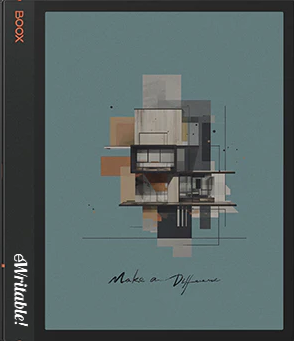 👍 Recommended | 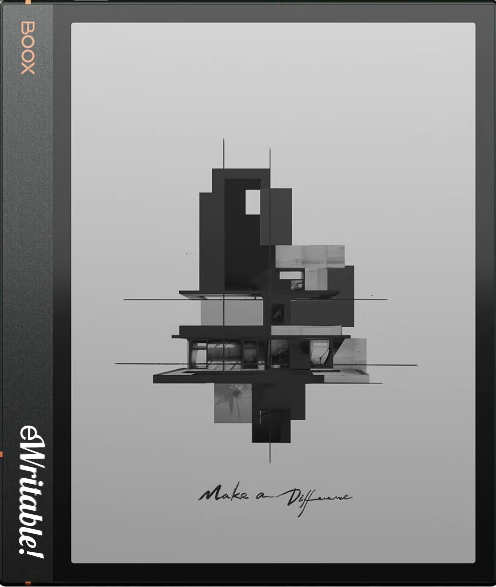 👍 Recommended | 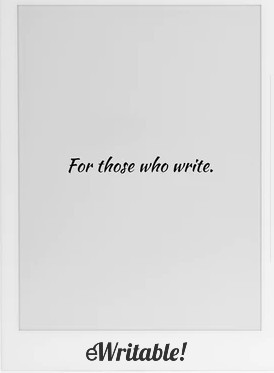 👍 Recommended | 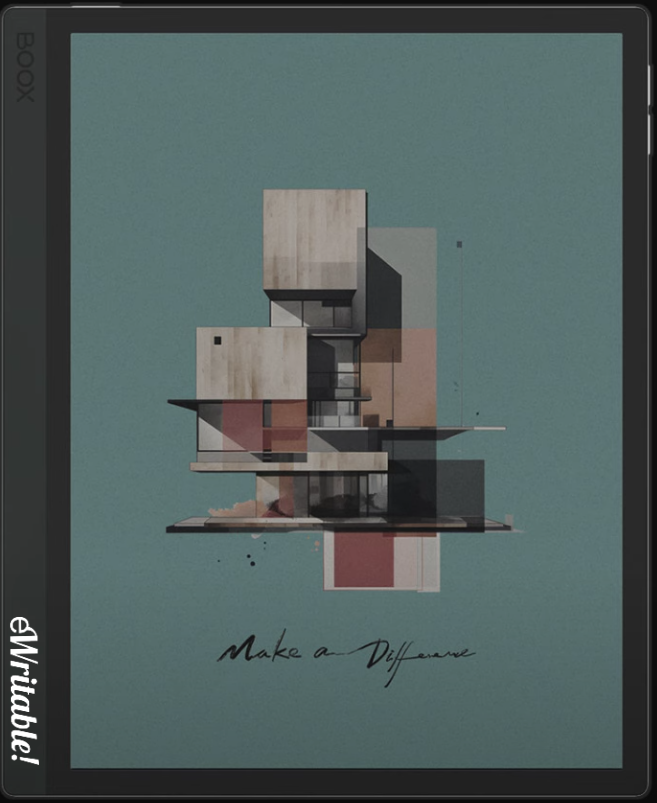 👍 Recommended | 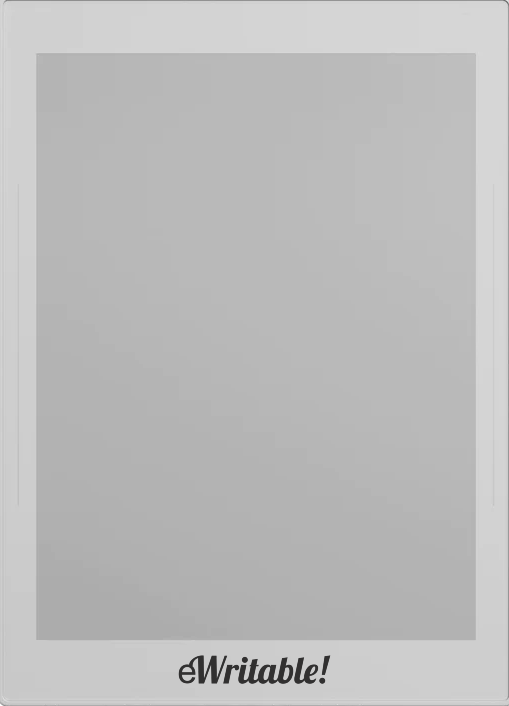 👍 Recommended | 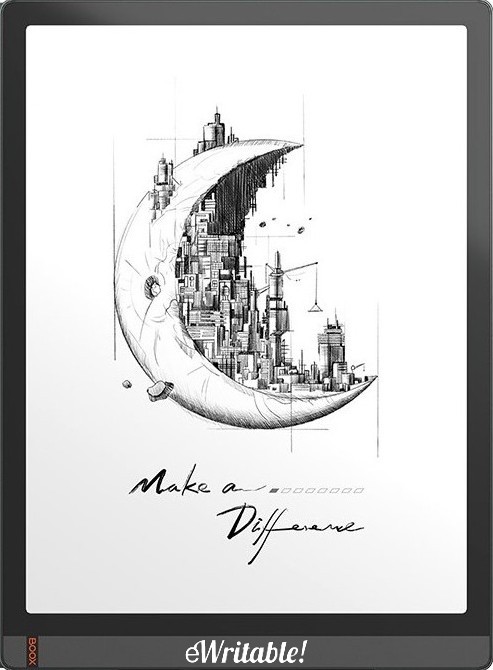 👍 Recommended | 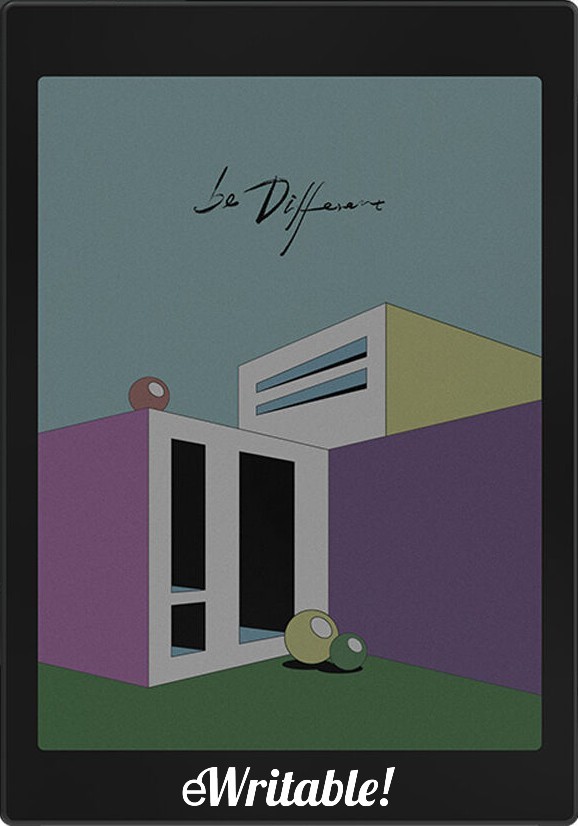 👍 Recommended | 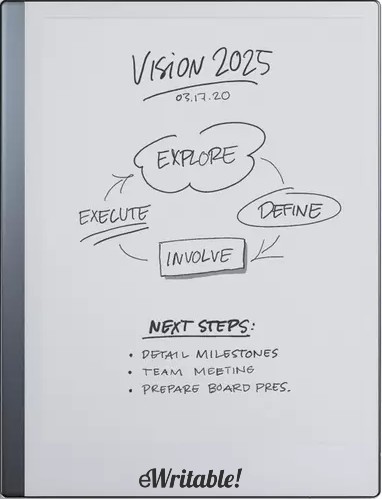 👍 Recommended | 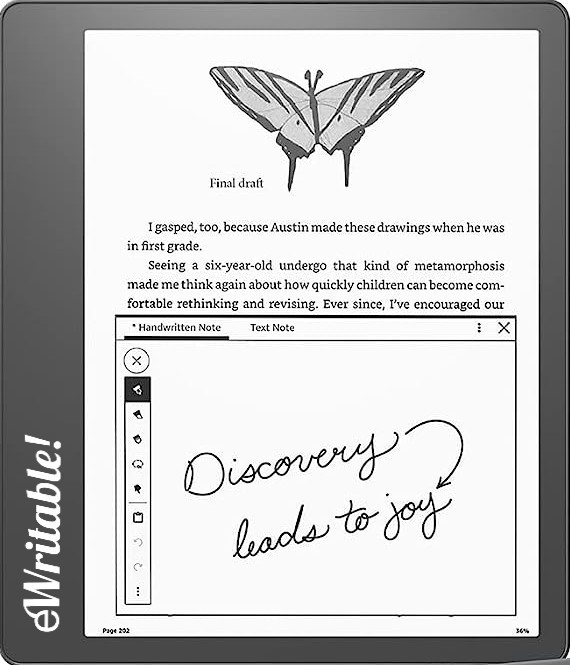 👍 Recommended | 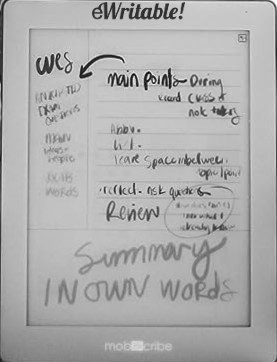 Okay |
| My Rating | ||||||||||
| Price (approx) | $500 | $400 | $525 Limited availability | $650 | $430 | $880 | $450 | $380 | $340 | $285 |
| Manufacturer | Onyx Boox | Onyx Boox | Ratta | Onyx Boox | Ratta | Onyx Boox | Onyx Boox | reMarkable | Amazon | Mobiscribe |
| Release year | 2023 | 2023 | 2020 | 2023 | 2023 | 2023 | 2023 | 2020 | 2022 | 2023 |
| SCREEN | BOOX NOTE AIR3 C | BOOX NOTE AIR3 | SUPERNOTE A5 X | BOOX TAB ULTRA C PRO | SUPERNOTE NOMAD | BOOX TAB X | BOOX TAB MINI C | REMARKABLE 2 | KINDLE SCRIBE | MOBISCRIBE WAVE |
| Screen type | Kaleido 3 | Carta 1200 | Mobius Carta | Kaleido 3 | Carta | Mobius Carta 1250 | Kaleido 3 | CANVAS with Carta | Carta 1200 | Carta |
| Screen size | 10.3" | 10.3" | 10.3" | 10.3" | 7.8" | 13.3" | 7.8" | 10.3" | 10.2" | 7.8" |
| Screen resolution (B/W) | 1860 x 2480 | 1404 x 1872 | 1404 × 1872 | 1860 x 2480 | 1404 x 1872 | 1650 x 2200 | 1404 x 1872 | 1404 x 1872 | 1830 x 2460 (approx) | 1404 x 1872 |
| Screen density (B/W) | 300dpi | 227dpi | 226dpi | 300dpi | 300dpi | 207dpi | 300dpi | 226dpi | 300dpi | 300dpi |
| Colour | ✓ (Kaleido 3) | ⨯ | ⨯ | ✓ (Kaleido 3) | ⨯ | ⨯ | ✓ (Kaleido 3) | ⨯ | ⨯ | ⨯ |
| Screen resolution (Colour) | 930 x 1240 | n/a | n/a | 930 x 1240 | n/a | n/a | 702 x 936 | n/a | n/a | n/a |
| Screen density (Colour) | 150dpi | n/a | n/a | 150dpi | n/a | n/a | 150dpi | n/a | n/a | n/a |
| Frontlight | ✓ | ✓ | ⨯ | ✓ | ⨯ | ✓ | ✓ | ⨯ | ✓ | ✓ |
| Wacom compatible | ✓ | ✓ | ✓ | ✓ | ✓ | ✓ | ✓ | ✓ | ✓ | ✓ |
| Buy | ||||||||||
| HARDWARE | BOOX NOTE AIR3 C | BOOX NOTE AIR3 | SUPERNOTE A5 X | BOOX TAB ULTRA C PRO | SUPERNOTE NOMAD | BOOX TAB X | BOOX TAB MINI C | REMARKABLE 2 | KINDLE SCRIBE | MOBISCRIBE WAVE |
| CPU | 2.4 Ghz octa-core | 2.4 Ghz octa-core | 1.3 GHz quad-core | 2.8 Ghz octa-core | 1.8GHz Quad-Core | 1.8 Ghz octa-core | 1.8 Ghz octa-core | 1.2Ghz dual-core | 1Ghz | 1.5 Ghz Quad-core |
| RAM | 4Gb | 4Gb | 2Gb | 6Gb | 4Gb | 6Gb | 4Gb | 1Gb | 1Gb | 4Gb |
| Storage | 64Gb | 64Gb | 32Gb | 128Gb | 32Gb | 128Gb | 64Gb | 8Gb | 16-64Gb | 64Gb |
| Battery | 3700mAh | 3700mAh | 3800mAh | 4600mAh | 2700mAh | 6300mAh | 5000mAh | 3000mAh | 3000mAh | 2500mAh |
| Super Refresh | ✓ | ⨯ | ⨯ | ✓ | ⨯ | ✓ | ✓ | ⨯ | ⨯ | ⨯ |
| Keyboard folio | ⨯ | ⨯ | ⨯ | ✓ | ⨯ | ⨯ | ⨯ | ✓ | ⨯ | ⨯ |
| Speakers | ✓ | ✓ | ⨯ | ✓ | ⨯ | ✓ | ✓ | ⨯ | ⨯ | ✓ |
| Microphone | ✓ | ✓ | ⨯ | ✓ | ⨯ | ✓ | ✓ | ⨯ | ⨯ | ⨯ |
| G-Sensor | ✓ | ✓ | ⨯ | ✓ | ✓ | ✓ | ✓ | ⨯ | ✓ | ⨯ |
| Ceramic Tip | ⨯ | ⨯ | ✓ | ⨯ | ✓ | ⨯ | ⨯ | ⨯ | ⨯ | ⨯ |
| Bluetooth | ✓ | ✓ | ✓ | ✓ | ✓ | ✓ | ✓ | ⨯ | ✓ | ✓ |
| Fingerprint scanner | ✓ | ✓ | ⨯ | ✓ | ⨯ | ⨯ | ⨯ | ⨯ | ⨯ | ⨯ |
| SD card slot | ✓ | ✓ | ⨯ | ✓ | ✓ | ⨯ | ⨯ | ⨯ | ⨯ | ⨯ |
| Rear camera | ⨯ | ⨯ | ⨯ | ✓ | ⨯ | ⨯ | ⨯ | ⨯ | ⨯ | ⨯ |
| Front camera | ⨯ | ⨯ | ⨯ | ⨯ | ⨯ | ⨯ | ⨯ | ⨯ | ⨯ | ⨯ |
| Waterproof | ⨯ | ⨯ | ⨯ | ⨯ | ⨯ | ⨯ | ⨯ | ⨯ | ⨯ | ✓ |
| USB-C | ✓ | ✓ | ✓ | ✓ | ✓ | ✓ | ✓ | ✓ | ✓ | ✓ |
| Width | 193mm | 193mm | 178mm | 184.5mm | 139.2mm | 228mm | 136.5mm | 187mm | 196mm | 148.3mm |
| Height | 226mm | 226mm | 245mm | 225mm | 191.85mm | 310mm | 194mm | 246mm | 229mm | 193mm |
| Thickness | 5.8mm | 5.8mm | 7.2mm | 6.6mm | 6.8mm | 6.8mm | 8.3mm | 4.7mm | 5.8mm | 8.1mm |
| Weight | 430g | 450g | 375g | 450g | 266g | 560g | 310g | 403.5g | 433g | 0g |
| Buy | ||||||||||
| SOFTWARE | BOOX NOTE AIR3 C | BOOX NOTE AIR3 | SUPERNOTE A5 X | BOOX TAB ULTRA C PRO | SUPERNOTE NOMAD | BOOX TAB X | BOOX TAB MINI C | REMARKABLE 2 | KINDLE SCRIBE | MOBISCRIBE WAVE |
| Operating system | Android 12 | Android 12 | Chauvet (Android-based) | Android 12 | Chauvet (Android-based) | Android 11 | Android 11 | Linux (Codex) | KindleOS | Android 12 |
| Google Play Store | ✓ | ✓ | ⨯ | ✓ | ⨯ | ✓ | ✓ | ⨯ | ⨯ | ✓ |
| Kindle support | ✓ | ✓ | ✓ | ✓ | ✓ | ✓ | ✓ | ⨯ | ✓ | ✓ |
| Handwriting search | ✓ | ✓ | ✓ | ✓ | ✓ | ✓ | ✓ | ⨯ | ⨯ | ✓ |
| Handwriting conversion | ✓ | ✓ | ✓ | ✓ | ✓ | ✓ | ✓ | ✓ | ✓ | ✓ |
| Insert shapes | ✓ | ✓ | ⨯ | ✓ | ⨯ | ✓ | ✓ | ⨯ | ⨯ | ✓ |
| Insert images | ✓ | ✓ | ⨯ | ✓ | ⨯ | ✓ | ✓ | ⨯ | ⨯ | ✓ |
| Split screen | ✓ | ✓ | ⨯ | ✓ | ⨯ | ✓ | ✓ | ⨯ | ⨯ | ⨯ |
| Custom templates | ✓ | ✓ | ✓ | ✓ | ✓ | ✓ | ✓ | ⨯ | ⨯ | ✓ |
| No. templates | 40+ | 40+ | 25+ | 40+ | 25+ | 40+ | 45+ | 45+ | 15+ | 50+ |
| Brush types | Fountain Pen, Paintbrush, Ballpoint Pen, Pencil, Marker | Fountain Pen, Paintbrush, Ballpoint Pen, Pencil, Marker | Needlepoint, Ink Pen, Marker | Fountain Pen, Paintbrush, Ballpoint Pen, Pencil, Marker | Needlepoint, Ink Pen, Marker (More brushes in Paint app) | Fountain Pen, Paintbrush, Ballpoint Pen, Pencil, Marker | Fountain Pen, Paintbrush, Ballpoint Pen, Pencil, Marker | Ballpoint, Fineline, Pencil, Mechanical Pencil, Highlighter, Marker, Calligraphy, Paintbrush | Pen, Fountain Pen, Marker, Pencil, Highlighter | Pencil, Fountain Pen, Paintbrush |
| Screen share | ✓ | ✓ | ✓ | ✓ | ✓ | ✓ | ✓ | ⨯ | ⨯ | ✓ |
| ADE support | ⨯ | ⨯ | ⨯ | ⨯ | ⨯ | ⨯ | ⨯ | ⨯ | ⨯ | ⨯ |
| File formats | PDF, EPUB, DOC, DOCX, PPT, PPTX, TXT, HTML, RTF, FB2, CBZ, CBR, AZW3, MOBI, PRC, DJVU, CHM, ZIP | PDF, EPUB, DOC, DOCX, PPT, PPTX, TXT, HTML, RTF, FB2, CBZ, CBR, AZW3, MOBI, PRC, DJVU, CHM, ZIP | PDF, EPUB, DOC, DOCX, TXT, CBZ, FB2, XPS | PDF, EPUB, DOC, DOCX, PPT, PPTX, TXT, HTML, RTF, FB2, CBZ, CBR, AZW3, MOBI, PRC, DJVU, CHM, ZIP | PDF, EPUB, DOC, DOCX, TXT, CBZ, FB2, XPS | PDF, EPUB, DOC, DOCX, PPT, PPTX, TXT, HTML, RTF, FB2, CBZ, CBR, AZW3, MOBI, PRC, DJVU, CHM, ZIP | PDF, EPUB, DOC, DOCX, PPT, PPTX, TXT, HTML, RTF, FB2, CBZ, CBR, AZW3, MOBI, PRC, DJVU, CHM, ZIP | PDF, EPUB | PDF, EPUB (via conversion), DOC, DOCX, TXT, RTF, HTML, KFX (Kindle), AZW3, MOBI (Limited support), AZW (Limited support) | PDF, EPUB, TXT, FB2, AZW3, MOBI, PRC |
| File formats (image) | PNG, JPG, TIFF, BMP | PNG, JPG, TIFF, BMP | PNG, JPG, WEBP | PNG, JPG, TIFF, BMP | PNG, JPG, WEBP | PNG, JPG, TIFF, BMP | PNG, JPG, TIFF, BMP | PNG, JPG | PNG, JPG, BMP, GIF | PNG, JPG |
| File formats (Audio) | WAV, MP3 | WAV, MP3 | - | WAV, MP3 | - | WAV, MP3 | WAV, MP3 | - | AAX (Audible) via Bluetooth | - |
| Buy | ||||||||||
| Where to buy | Boox Euro Shop Boox Shop Reseller (CA) Amazon BE Amazon DE Amazon ES Amazon FR Amazon IT Amazon NL Amazon PL Amazon UK Amazon US eBay AU eBay CA eBay DE eBay ES eBay FR eBay IE eBay IT eBay UK eBay US | Boox Euro Shop Boox Shop Amazon UK Amazon US eBay AU eBay CA eBay DE eBay ES eBay FR eBay IE eBay IT eBay UK eBay US | Ratta Supernote Supernote EU (not UK) Supernote Outlet eBay AU eBay CA eBay DE eBay ES eBay FR eBay IE eBay IT eBay UK eBay US | Boox Euro Shop Boox Shop Reseller (CA) Amazon BE Amazon DE Amazon ES Amazon FR Amazon IT Amazon NL Amazon PL Amazon UK Amazon US eBay AU eBay CA eBay DE eBay ES eBay FR eBay IE eBay IT eBay UK eBay US | Ratta Supernote Supernote EU (not UK) | Boox Euro Shop Boox Shop Reseller (CA) Amazon BE Amazon DE Amazon PL Amazon UK Amazon US eBay AU eBay CA eBay DE eBay ES eBay FR eBay IE eBay IT eBay UK eBay US | Boox Euro Shop Boox Shop Reseller (CA) Amazon BE Amazon DE Amazon PL Amazon US eBay AU eBay CA eBay DE eBay ES eBay FR eBay IE eBay IT eBay UK eBay US | ReMarkable eBay AU eBay CA eBay DE eBay ES eBay FR eBay IE eBay IT eBay UK eBay US | Amazon AU Amazon CA Amazon DE Amazon ES Amazon FR Amazon IT Amazon UK Amazon US eBay AU eBay CA eBay DE eBay ES eBay FR eBay IE eBay IT eBay UK eBay US | MobiScribe Amazon DE Amazon US eBay AU eBay CA eBay DE eBay ES eBay FR eBay IE eBay IT eBay UK eBay US |
| PRODUCT | BOOX NOTE AIR3 C | BOOX NOTE AIR3 | SUPERNOTE A5 X | BOOX TAB ULTRA C PRO | SUPERNOTE NOMAD | BOOX TAB X | BOOX TAB MINI C | REMARKABLE 2 | KINDLE SCRIBE | MOBISCRIBE WAVE |
About the author
Dan Dutton is passionate about E-ink writing tablets, which bring together the pleasure of writing on paper with the power of digital technology. When he bought his first tablet, he realised that there wasn't a lot of unbiased information available for people that were considering buying an E-ink tablet, and so he built eWritable.



Good Comprehensive Review.
I have not been following all the brands, but the one’s you have chosen were mostly on my radar, and roughly in the order I could have placed them myself.
Note Air 3c seems to be king for both versatility and price, plus I think I found a universal folio keyboard (and for a decent price too) that will work with it- effectively making it into a cheaper and lighter Ultra Tab C Pro.
But you also got me looking at that A5 device- I do like taking lots of notes on paper. But they are not organized, in huge stacks, and they obviously to not have a hyperlinks. I eventually type them out onto my computer.
This also made me look twice at the remarkable with its typewriting capabilities. Just as I do a lot of writing, I do a lot of typing. I used to look for dedicated typewriters but E-ink tech was too small and the brother dedicated electric typewriters too noisy.
Funds permitting, your article has convinced me that I ought to buy NA3C (with a universal keyboard) and then perhaps look at the A5 for organizational sake. Perhaps the second would increase my productivity, and remove some distractions.
Thanks, again.
The NA3C and A5X are the only e-ink tablets I use with any conviction. The A5X I use daily for note-taking, with the NA3C being pulled out of my bag primarily for research and study tasks. I also do a bit of typing with the NA3C and a cheap BT keyboard. Could you drop a link to the keyboard folio you found? It sounds very interesting 🙂
Hello,
I posted the links in BB code, hopefully it will work- we will soon find out…
The first thing I found was from Logitec: Logitec Universal Folio
In my opinion, I don’t like the idea of a 2 year battery life and then have to replace it. But that is just me.
But I also did a scatter shot research and found these:
Universal Keyboard 1
TouchPad Keyboard Case
ProCase
GoodCase
SeeTopTu Universal Tablet Keyboard Case
-These are supposed to be rechargeable universally compatible bluetooth keyboards. I saw that they had Android in their long lists, hoping that they would also be compatible to Boox devices since they use android. While they do not have a 2 year charge, I think I can live with that.
-Some of these companies have smaller sizes for smaller devices.
I have not refined my search to a specific unit yet (i.e. doing review investigations), but if any of these units work as I hope they do, then NA3C, for me, would be the ideal and cheapest option.
Hopefully this helps.
Cheers,
Well, the BB code did not work… oh well
Cheers for this – I’ll take a proper look at these when I have a little more time. In the meantime, I’ve neatened up the links 🙂
Thank you for neatening them up. How do I post proper hyperlinks here? Or is this something only you have access to?
Also as a quick correction on the line that says:
“Some of these companies –of– smaller sizes for smaller devices”
should read:
“Some of these companies –have– smaller sizes for smaller devices”
Cheers,
Hey Matt,
I made the correction.
On the admin console, I have some buttons that just add bog standard HTML tags to the text, so links are simply “a href” (obviously with the angle brackets added), however I’m not sure if this would work for others – I’m guessing it would but not 100% sure. I’ll perhaps look at adding some sort of wysiwyg to the comments section to make it easier for others.
Cheers,
Dan
Just in case it hit your spam or junkbox, I sent you an email about the Procase keyboard folio and my initial thoughts about it. I am waiting for the NA3c to come in before I give it a proper test run.
Hey Matt,
Cheers for this – I did receive your email but have had a manic weekend and it was a ‘teacher training day’ yesterday so I stayed at home with my youngest daughter. I’m just in the process of going through my emails from the weekend and will reply 🙂
Dan
That is great review. Just have one question, can you turn off colour and switch on monochrome screen on on TUCP?
No, not as far as I’m aware. Well, not natively anyway – it may be possible to do with third party software maybe.
I found a guide that apparently allows you to get at some advanced options for the Android which allow you to change the colour in the TUCP without jailbreaking it. It apparently works on any device that has a dedicated GPU, which the TUCP has.
GUIDE: Enabling grayscale mode on Tab Ultra C (How to turn off all colours)
https://www.reddit.com/r/Onyx_Boox/comments/13d2sww/guide_enabling_grayscale_mode_on_tab_ultra_c_how/
I’ve always been tempted to pull the trigger on the remarkable, but never do. I typically take notes and sketch on steno pads, so I’ve been weighing the Boox mini c vs the SN Nomad. Thoughts?
Both would be good choices. You’ll get better battery life on the Nomad but you have colour and the ability to install 3rd-party apps on the Tab Mini. Also (in my mind), the Nomad feels more analogue, like using a pad of paper, and the Tab Mini feels more like using an electronic device.
What was updated in this article? I could not find it at a glance. It might be useful to stick “Update” in whatever section was added or changed.
Hey Matt, I added the Supernote Nomad to the 7.8″ category earlier in January but nothing was updated when the article came to the top of the list last week – I was actually experimenting with some code to bring updated articles to the top of the list and didn’t remove it again afterwards.
This is a great review!
Wondering if you could help suggest for a unique use case. I am studying for a promo exam, all of the books for this exam have been uploaded to a cloud and are PDF files with lots of images. There are over 100 books that I will need to go through.
I want something that is very minimalistic, I do not need any distractions of social media or any other apps. I need to be able to download the pdf’s or upload them to the e-reader from my computer and be able to read and take notes on the pdf. Would love to be able to search those notes while studying at later dates.
I kind of narrowed it down to the Supernote and Note Air3. I also saw the recommendation of the tab x, interested on your thoughts on what you might think would serve me best.
TIA!
Hey Jon,
Thanks for commenting.
I think a Boox device is probably better for this use case because they tend to have more storage and RAM and a better (imo) native PDF reading/annotating software. If there is colour on the PDFs, then Note Air3C would be better, but if they are monochrome, then either the Tab X or Note Air3 (without the C). Personally, I find PDFs tend to look better on the larger 13.3″ screen but 10.3″ aren’t terrible (and the Tab X is rather expensive).
The Boox range is not as minimalistic as the Supernote but you are not required to install/use any other apps than you need – I think it depends how easily distracted you are. You should be able download the files directly from the cloud to the Boox, rather than using your PC as an intermediary. I’m not quite sure if you can search handwritten notes on a PDF so I’ll have to check that and get back to you – you can certainly search handwriting in a notebook if, for example, you used split-screen mode to have the PDF on one side of the screen and a notebook on the other rather than writing directly on the PDF.
Hope this helps,
Dan
Dan
Thank for your reviews.
Can you give some information about handwriting conversion in other languages (in particular Italian)? Which devices with handwriting conversion support this?
Thank you very much
Hey Federico,
Thanks for your comment.
I know that Boox, Supernote, reMarkable, and Kindle Scribe support handwriting conversion in Italian (and many other languages) but am unsure about others.
Unfortunately I can’t read any language other than English, so am unable to test how good this is.
Dan
There’s an update in the software for the Supernote Nomad A6X2 now allows for sideloading APKs. They made it a fairly simple option with a toggle for allowing sideloaded APKs.
I updated the software on my A5X and sadly, it isn’t there. So far, only works on the Nomad.
One video showed how and apparently if you don’t trust mirror sites, some developers will let share the APK with you directly.
Hey Elisa,
Thanks for commenting – you’ve reminded me that I need to update this article to reflect this new feature on the Supernote.
I did write about this feature a while ago – whilst turning on sideloading support is simple, the process of sideloading over adb is a little more complex, requiring the command line.
As you rightly say, the feature isn’t available on the a5x, however it is still possible to sideload using a somewhat ‘hacky’ technique to access android settings via the kindle app.
Cheers,
Dan